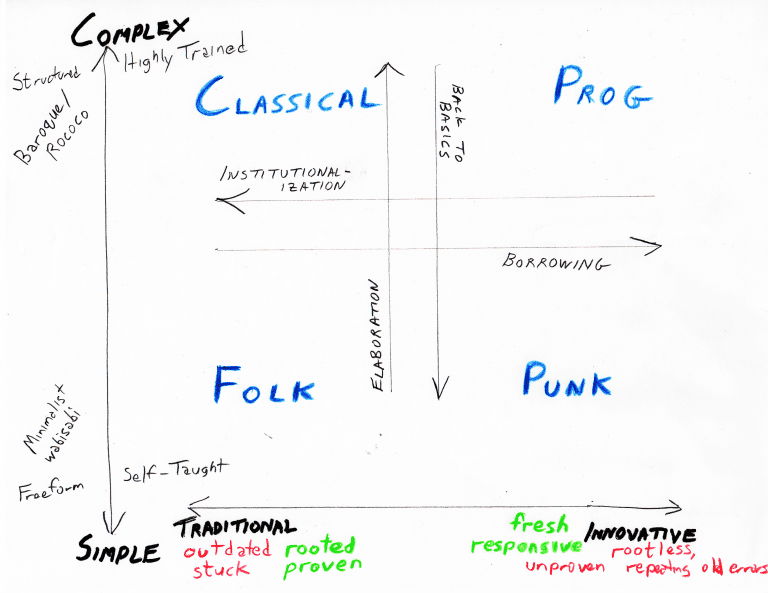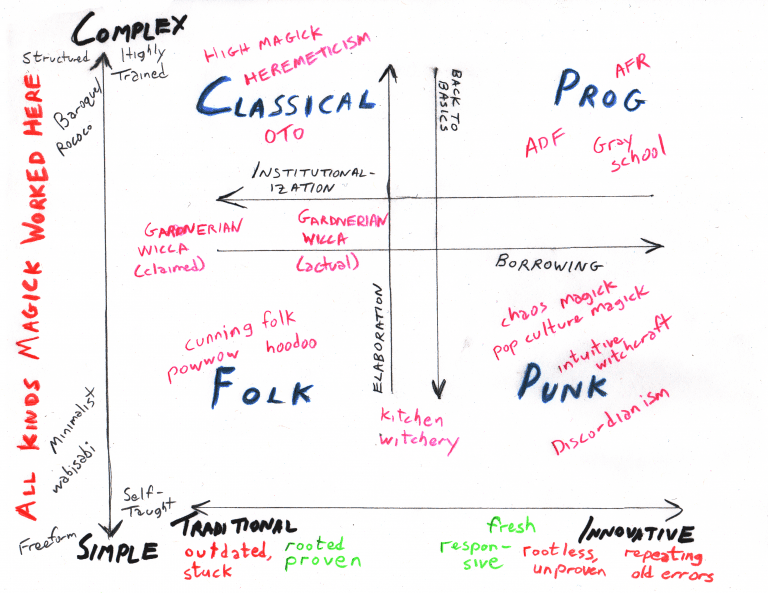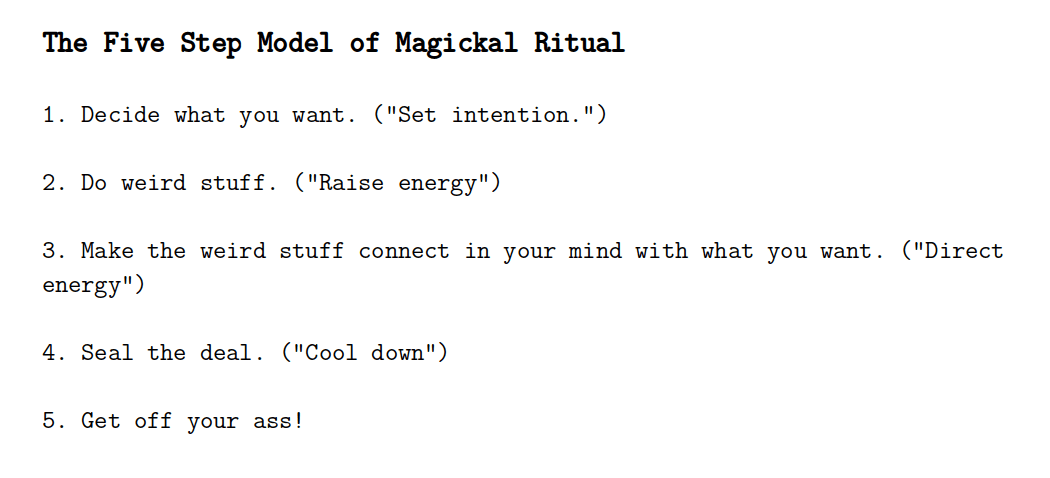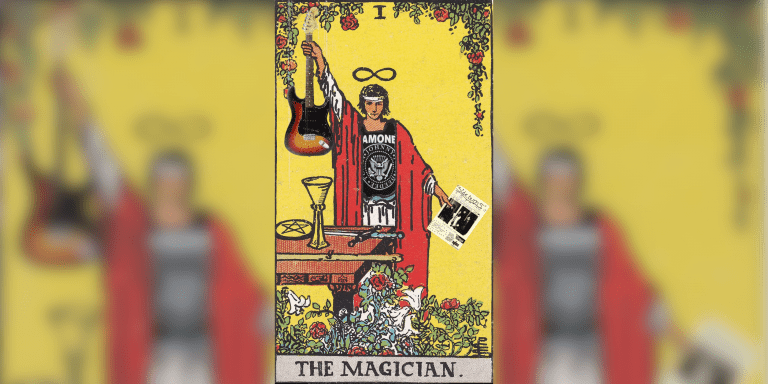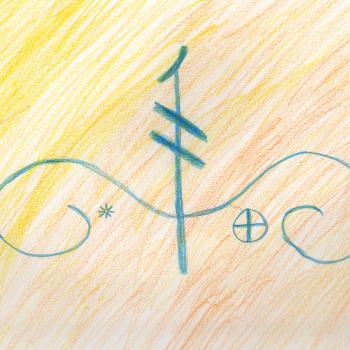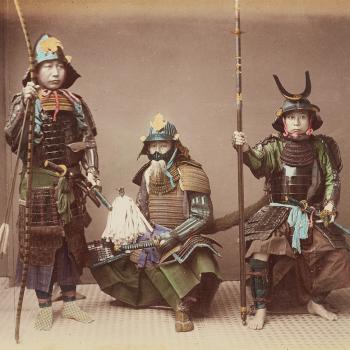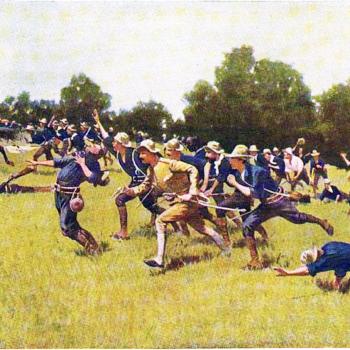I recently had the honor of presenting at the WinterStar Symposium. I got to talk about something I’ve been thinking about for a few years now but haven’t really talked much about yet, boiling the practice of magick down to its absolute essentials. I call it “punk magick”. These are my notes, or you can watch the video of the talk below.
Hi! Thank you for coming. If you don’t know me, I’m Tom Swiss. Let me take a second for some self-promotion: I’m the author of the books Why Buddha Touched the Earth and What Does It Mean For The Gods To Exist (you can find book links at my website, infamous.net), and I blog at Patheos as The Zen Pagan. I’ve been coming to Starwood for over twenty years but this is my first WinterStar, so, thanks to the organizers for having me.
So what I’d like to talk about today is a framework for thinking about magic. I don’t know your own background — one time I gave a talk about magic at Starwood and Oberon Zell came, which was kind of like having Jimi Hendrix show up to your guitar recital. If you’re new to this stuff I hope it will be a useful orientation, and if you’re an expert I hope you’ll at least find one or two ideas worth taking with you.
We’ll have time for open discussion at the end, so if you have comments or questions that sort of build on the topic or go off on tangents I’ll ask you to hold until then, maybe make a note for yourself. I think that will work better for this Zoom format. But if there’s something that’s not clear as we go, please do jump in and ask. I’m not sure how we’re going this, if you’re going to be muted on Zoom, but if so I think if you “raise your hand” I’ll see it, or Nancy will and can jump in and let me know. I also will have the chat window open and will try to watch that out of the corner of my eye, so feel free to tell me there how clever, funny, and handsome I am. Ahem.
Anyway. So what I want to talk about is a framework for thinking about the art of magick — and for thinking about art in general — that can help you find whatever style is right for you and encourage you to be an active participant.
Let me start by talking a little about my own history and how it got me thinking this way. This developed out of work I’ve done over the years at for the Fire Circle at the Free Spirit Gathering.
Now, I’m just going to presume that you’ve have some idea what a Fire Circle is, because that’s a topic I could talk about for a whole other hour. And FSG, if you’re not familiar, is a mid-size festival in Maryland, sort of my home event.
So many years ago, we were having a big disagreement in the community about our Fire Circle. What brought it to a head was that one night some poor guy got it into his head to try to jump the fire. And he did not clear it — I was not down there that night, so I have only second-hand reports, but he scorched himself good. He survived, but the incident harshed everyone’s mellow for the rest of the festival.
And then we had some people who’s response was “see, these party people at the Fire, they’re the root of all evil, this is Sacred Space, it should be Formal and Solemn with No Tomfoolery.” This was all taking place on an e-mail list in the off season, and there was one post that said that there should be no talking — certainly no LAUGHING — while there was drumming going on.
And we had some folks who were “I’m just here to party with my friends, leave us alone, don’t tell me what to do, this is a gathering of many ways and we don’t have to do things your way.”
And a lot of what I’ve tried to do with group magickal workings over the years, has been about trying to balance between those two extremes. It’s an old dilemma, right? Apollonian and Dionysian.
So as this discussion went on, and I was trying to find some common ground or greatest common factor, I got a little inspiration. I tried to boil down the Fire Circle to its absolute essentials.
It’s what I call the Fire Circle Triangle. If you’ve got 1) a fire with a bit of magickal intent, 2) people drumming, and 3) people dancing in a circle around the fire, you’ve got a Fire Circle. Anything else is just a question of style.
And I was able to get buy-in from the community about it. Which might be my greatest work of magick ever, getting a fractious community to agree on something! My little prose-poem about it appeared in the FSG program for many years after, it sort of took on a life of its own.
This was after only my third or so time there, long before I got involved in the organizational politics. It meant a lot to me that people were listening to a relative newcomer.
Now a year or two after that, we had Jeff McBride — a.k.a. Magnus, if you don’t know him he’s sort of a big name guy, a successful performing magician who also knows a lot about ritual magick — come and run the Fire Circle for us for one or two nights. It wasn’t his full Alchemical Fire Ritual thing, but even a scaled down version is pretty structured. And a few years after that he did come and do a whole AFR track for us.
Now let me be clear that I have the highest respect for Magnus. As a performer he is a trouper, and as a wisdom teacher he walks his talk. A+, all the way.
But the AFR is a lot more structured that Fire Circle Triangle thing I’d been talking about. If you’re not familiar he’s got a whole theory about astrological correlations of different zones around the fire, and different parts of the night being different parts of the alchemical process. Lots of structure.
And somewhere along the line where I was talking about the contrast, I hit on the metaphor of rock and roll, and punk versus prog.
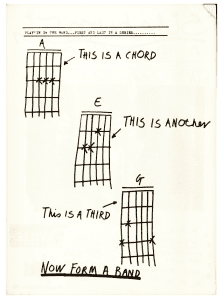
FIGURE 1
“…Now form a band”
In the 1970s, as punk rock was developing, the zine Sideburns featured a cartoon showing three guitar chord shapes, with the words “This is a chord. This is another. This is a third. Now form a band.”
This is a fantatic summary of the punk rock approach to music: strip the art down to its absolute bare essentials, and go forward confidently, with a “do it yourself” spirit to engage directly with the art.
In contrast, we have progressive rock. Rather than stripping things down, prog rock added complex orchestration — the sort of thing you usually find in classical music or maybe jazz rather than rock and roll — and lots of production in the studio.
And it strikes me that in every art, we can find these two trends: adding on, and striping away.
In live theater you’ve got elaborately staged musicals and you’ve got plays meant to be staged in minimalist “black box” theaters. (Or even, in the age of COVID-19, staged on-line with the actors in their own homes.)
Poems range from multi-volume epics with complex patterns of rhythm and rhyme, to brief haiku, or works of “prose poetry” in a very natural language.
Painting can be hyper-realistic, or can try to capture the essence of a scene on a few brushstrokes.
One trend to build up and elaborate, the other to simplify and get back to the fundamentals. Baroque versus wabisabi.
We could be fancy and call them metabolic and catabolic processes. But I’m a rock and roller, and I like to think of them as “prog” and “punk”.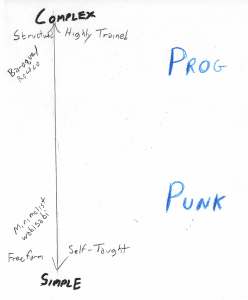 FIGURE 2
FIGURE 2
Punk and Prog
And neither of these is better than another! They are two parts of a cycle, a yin and yang pairing. But a person’s taste will usually run more to one than to the other.
The Four Quadrants of Art
To really get the picture I think we have to add a second axis, of tradition versus innovation.
FIGURE 3
The Four Quadrants of Art
Then we have The Four Quadrants of Art: Classical, Folk, Prog, and Punk.
And we have currents running up and down, left and right, in our diagram. Elaboration turns punk to prog, or folk to classical; back-to-basics goes the other way.
Institutionalization makes new things traditional over time, so prog becomes classical and punk becomes folk. Borrowing runs the other way, new things yoink from traditional things.
So with the warning that the map is not the territory, let’s think about where some various schools and styles and magickal/religious groups go here.
In the art of ritual magic, a lot of what we have is “classical”. This “high magick”, the Heremetic – Golden Dawn – Aliester Crowley sort of sense, has its roots in the 19th century. Some upper-class people involved in movements like Theosophy and Freemasonry started using ritual magic as a tool for spiritual development. These were generally people who could afford to purchase lots of books and elaborate ritual tools, furnish special spaces for magical work, and devote leisure time to extended magical workings.
And there’s a general trend in occultism to look backwards, trying to find that Ancient Hidden knowledge. There’s often an underlying assumption that the past was more magickal. (A bad assumption!) So traditional and complicated — classical. We put that stuff in the upper left here.
It’s interesting that I do see more people talking about this sort of magic than I did ten or twenty years ago. Like, I recently heard a piece on the Inpired podcast (the new name for the Interfaith Voices show) about Damien Echols, a guy who did 18 years in prison after a false conviction, and how ritual high magic was what kept him sane. Never though I’d hear that as a topic on an public radio show founded by a nun.
FIGURE 4
Styles of The Art Magickal
In the 20th century we have the rise of modern witchcraft, especially Gerald Gardner’s Wicca. This sort of witchcraft is sometimes called “low magic” to contrast it with the “high magic” of elaborate ritual.
But while Wicca and the spiritual paths that derived from it have some roots in folk magic — magic for the masses! power for the people! — they were still influenced by the Heremetic tradition. They usually still have a hierarchical structure with various degrees of initiation, and formalized teacher and student roles. And Garner’s narrative — which, let’s be clear, is pretty much debunked — is that he was reviving an ancient tradition that had been kept secret.
So maybe we should give Uncle Gerald two spots on our graph here, for the ancient tradition somewhere near the border of classical and folk he claimed to be doing, and one further to the right for the innovative synthesis he was sneaking in.
And then we have folk magic at bottom left. It’s traditional but doesn’t need anything complicated. There’s not a lot of formal history to it — just like all those folk song attributed to “Traditional”, these workings spread within communities by word of mouth rather than by being written down and published, or taught in a formal curriculum.
Different forms here, European “cunning folk”, hoodoo here in the US, Pennsylvania Dutch powwow. Kitchen witchery, a lot of traditional elements but also some looking to do new stuff, I’ll put them on the border between folk and punk. We could certainly debate the details, I don’t want to get too hung up on these examples, they’re just broad illustrations.
In the upper right we might put groups like ADF, which do have a formal curriculum, and even as they look to the past they are explicit about trying to do something new. Up here we might also put the AFR. Maybe the Gray School of Magic, another group trying to develop a new formal curriculum, would go up there too.
And all of these are fine and noble approaches, but I want to focus on this bottom right corner.
Chaos magick, where the workings use a pretty simple sigilization — you can find sigil generators on-line — might go here. Pop culture magic, too. Discordianism, the Turkey Curse is pretty punk, as the the idea that every person on Earth is a Pope (someone not under the authority of the authorities) and that the way to become an official Episkopos of The Discordian Society is to declare yourself one. A lot of what I see people doing under the label “intuitive witchcraft”, making up their own thing, would go here.
Frederick Douglass’s Root Magick
So I mentioned hoodoo a minute ago, and that gives me an excuse for a Black History Month magickal tangent about Frederick Douglass, the Maryland-born American hero. Douglass didn’t know his actual birthday but celebrated it on February 14th, so, I think it’s very appropriate to take a moment for this tangent.
As a teen Douglass was living in Baltimore, he worked in the shipyards in Fells Point. (The ones that the British has wanted to burn in 1814, that lead to the Battle of Baltimore and the Star Spangled Banner. But that was before he got there, and is a tale for another time.) But when he was about 16 he was sent to back to the Eastern shore and hired out by his supposed “owner” to a man named Covey, who was a brutal guy with a reputation for breaking rebellious slaves.
Douglass had a friend named Sandy, who was a rootworker. Rootwork is another word for hoodoo, that folk magic that comes out of African traditions but also mixed in some Appalachian Scots-Irish stuff from European folk magic and some Native American stuff. (And Byron Ballad will be talking about the Appalachian side of that tomorrow at 12:45, right here on WinterStar Channel 1.)
Anyway, Douglass’s friend Sandy the rootworker advised him to carry a certain root as protection against being beaten. He doesn’t name the root, and I’m not an expert but I’d guess it was John the Conqueror root.
Well the next day Covey attacked him. Douglass wrote about it his autobiography:
Mr. Covey entered the stable with a long rope; and just as I was half out of the loft, he caught hold of my legs, and was about tying me. As soon as I found what he was up to, I gave a sudden spring, and as I did so, he holding to my legs, I was brought sprawling on the stable floor. Mr. Covey seemed now to think he had me, and could do what he pleased; but at this moment—from whence came the spirit I don’t know—I resolved to fight; and, suiting my action to the resolution, I seized Covey hard by the throat; and as I did so, I rose.
Now that’s very interesting. “[F]rom whence came the spirit I don’t know.” That sure sounds like magick at work to me: a strength you didn’t know you had, a spirit moving you in the direction of your best and most courageous self.
They fought for nearly two hours before ending in a stalemate. Douglass was never whipped again, and said the incident was what put him on the path to freedom.
Later, he talked about it with Sandy. And it’s also interesting that he claimed to not believe that the root had anything to do with it.
We used frequently to talk about the fight with Covey, and as often as we did so, he would claim my success as the result of the roots which he gave me. This superstition is very common among the more ignorant slaves.
But if the root magick had nothing to do with the fight, why did he even bring it up?
Sounds to me like he had a divided mind — as most of us do — with his conscious mind rational and skeptical, dismissing the idea that carrying some root could help him. But his unconscious mind was open, credulous, maybe even superstitious.
His rational side may have been willing to fight back, but also scared of the consequences. Trusting to magic, telling his credulous side a magical story of empowerment, created the possibility for change to happen.
So that’s a really good and powerful example of magic. Given the significance of Douglass to the abolition movement, this fight might be called a turning point in American history — and it was catalyzed by a very simple bit of root magic.
Pretty cool, I think. Might even say it was punk as fuck for a slave to give himself permission to fight back just by carrying a piece of a root.
Ok, end of tangent.
With this big picture to orient us, what I want to do here is take the attitude towards magic that that famous Sideburns cartoon took to music. Instead of three chords I’m going to boil magic down to an Easy Five Step Process, and send you out to Do It Yourself.
In fact, our first order of business ought to be to let you in on a secret:
You — yes, ***YOU*** — Are Already A Magickian
You Are Already A Magickian
In a lot of our myths and stories, we have an idea that magic is this very special thing that is only for some very special people who were born that way.
Harry Potter is a Prophesied Chosen One. So is Tim Hunter in Neil Gaiman’s The Books of Magic.
In Ursula LeGuin’s Earthsea novels, the wizardly protagonist Ged demonstrates his precocious magical power as young child.
In the Arthurian mythos Merlin inherits his powers from a demon father.
One of our best-known fictional wizards, Gandalf from The Lord of the Rings, isn’t even human — he’s something more like an angel given human form, created by that world’s god specifically to assist and guide mortals.
Now, literary conventions are a thing. We know that in a mystery, the detective is destined to solve the case; in a romantic comedy we know that the couple will Live Happily Ever After. In an action movie we know that the bad guys will miss when they shoot at the hero.
These conventions have entertainment value, they orient us to the story, but they can also distort our understanding of crime, or romantic relationships, or accomplishing difficult tasks, or whatever is the topic of the story.
So the same is true about magic. We have to be careful about what we learn from fiction about it.
And the first thing to put away is the idea that magic is only for some special people. As Aleister Crowley put it, “Every man should make Magick the keynote of his life.” (We of course would expand that with gender-neutral language today.)
You might not know it but you’re already doing magick. We’ll come back to that point at the end.
Now, this very logical argument that magick is for everyone might not be enough. You might accept it intellectually but it might not reach your heart.
Starwood veterans might not need me to tell them that they are magick. But some of y’all, or some people who might see a recorded version of this later, might be new to it all.
So, what we’re going to do, is a little magickal working, a transmission, an attunement, an investment, a little charge. This is meant to apply not just to this talk, by the way, but this whole event. We’ve got some people coming up who are much more magickal than I, but this little working is going to attune you so that they can give you a good zap. Maybe I can even give you a little zap myself.
Now this is MAGICK. We are by defintion not bound by the ordinary rules of time and space. So it doesn’t matter that you’re far away on Zoom, or seeing this months or years later.
The first part of this is me convinicing you — not just intellectually but on deep level — that I am magician enough to pass the power on to you. So:
My friends, do you want to do magick? You can tell the universe your assent even if your mic is off, or
nod your head or make a thumbs up for the camera.
And I ask you again, do you want to do magick?
And I ask you a third time, because we need to be sure about this — do you want to do magick?
Then
HEAR ME!
I am Thomas, son of Mark and Suzanne.
I am the Star Chaser, the Zen Buffalo.
I have walked with legendary warriors and great wizards
I have breathed life back into the dead
With these hands I have made the lame walk, I have cast down enemies, I have led hundreds in making magic
I am known from one side of the world to the other.
I am warrior and bard, magickian and healer.
I have climbed sacred mountains, followed visions that led me to enchanted groves, been blessed by the breath of the sky
I have kindled the fire, led the dance, beat the drum.
I am in my place of power, with the altar of my ancestors and the altar of my gods. And to sanctify this place and focus the power, I make now the ancient sign of the pentacle.
[draw pentacle with wand]
And by my deeds and by my songs, by my blood and by my bone, I tell you this:
That it is no small thing that has brought you here and now to hear my words
Let all doubts be purged and left behind, all fears dissolved.
For a moment now, close your eyes. [sound singing bowl]
Take now a deep breath, pulling in energy from the world around you. And let it out.
Take now another deep breath, pulling up energy from the Earth beneath you, the Earth which always supports you. And let it out.
Take now a third deep breath, pulling down energy from the sky, from the heavens, from the sun and the stars that shine upon you. And let it out.
And let your eyes open.
By the power of this time and this place, I tell you this:
That this is the call to magic.
That this is the sign you have awaited.
Whether you now set foot on the path of magic for the first time, or whether you now renew a master’s or a journeyman’s practice of years or decades:
I tell you that the student is ready, and by the ancient law, the teaching now appears.
You. Are. A. Magickian.
You. Are. A. Magickian.
You. Yes, you. Are. A. Magickian.
So mote it be.
[pause]
[un-draw pentacle with wand]
(I have spoken. So say we all.)
All right? Everybody accept that they are magickians? Do I need to browbeat anyone into accepting it?
Great. So now that you are committed to doing magic — what is magick?
Whaddya Mean, Magick?
I often refer to Aleister Crowley’s definition that “Magick is the Science and Art of causing Change to occur in conformity with Will.” Old Uncle Aleister then goes on to say that “Every intentional act is a Magickal Act.”
A few other definitions offered by experts:
- Dion Fortune wrote that magic is “the art of changing consciousness at will.”
- In another piece, Crowley wrote that “Our Ceremonial Magic fines down, then, to a series of minute, though of course empirical, physiological experiments, and whoso will carry them through intelligently need not fear the result.”
- According to Margot Adler, her book Drawing Down The Moon: “Magic is convenient word for a whole collection of techniques, all of which involve the mind. In this case, we might conceive of these techniques as including the mobilization of confidence, will, and emotion brought about by the recognition of necessity; the use of imaginative faculties, particularly the ability to visualize, in order to begin to understand how other beings function in nature so we can use this knowledge to achieve necessary ends.”
Maybe this almost sounds like some sort of self-help gimmick. Like we might have some sort of “The 7 Magical Practices of Highly Effective People” book on the shelves of corporate managers across the country.
And that’s…not entirely wrong. Daniel Lawrence O’Keefe said that part of magic is “speaking in the management voice before you belong to the management.” There is that practical, getting-shit-done side to magic. A lot of folk magic is about that.
But magic is something deeper. It is intimately bound up with spirituality — with our relationship with ourselves and with the universe.
Because magic is also about poetry. One of my favorite definitions comes from Ross Nichols, who was the founder of the Order of Bards, Ovates and Druids: “Ritual is poetry in the realm of acts.”
And speaking of poetry, Charles Leland wrote in his preface to Aradia, or the Gospel of the Witches, “And so all was, and is, in sorcery a kind of wild poetry based on symbols, all blending into one another, light and darkness, fire-flies and grain, life and death.”
But yes, you can still use magic on the job! Depending on your profession, you might not choose to tell your colleagues about your workings. But as you let more magic into your life you may find that it pulls you down an entirely different career path than anything you imagined.
To summarize all this, I’d like to propose a five point definition of magick.
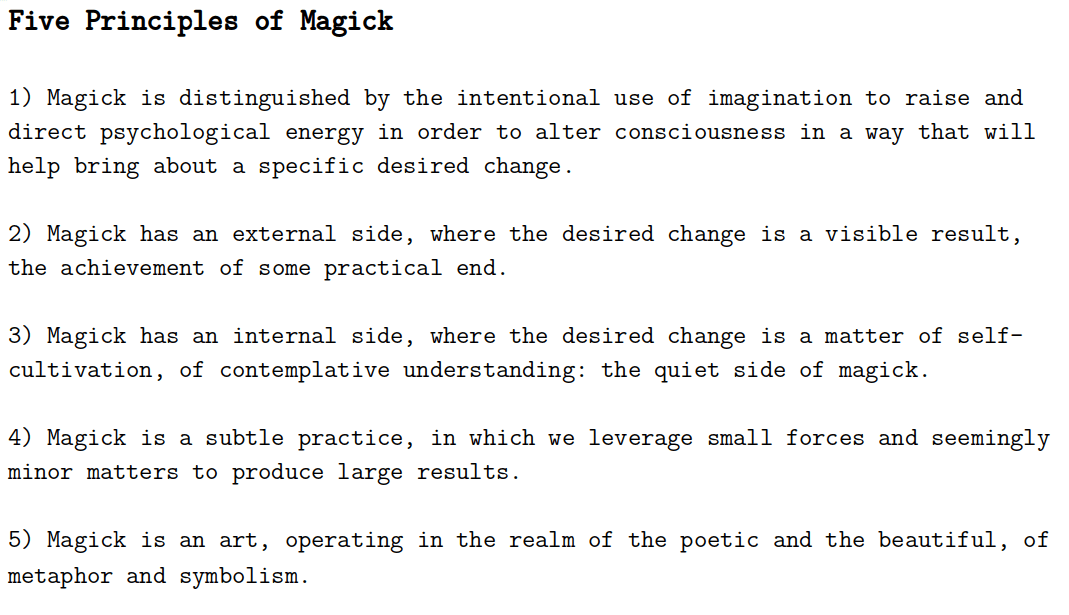 FIGURE 5
FIGURE 5
Five Principles of Magick
Five Principles of Magick
1) Magick is distinguished by the intentional use of imagination to raise and direct psychological energy in order to alter consciousness in a way that will help bring about a specific desired change.
2) Magick has an external side, where the desired change is a visible result, the achievement of some practical end.
3) Magick has an internal side, where the desired change is a matter of self-cultivation, of contemplative understanding: the quiet side of magick.
4) Magick is a subtle practice, in which we leverage small forces and seemingly minor matters to produce large results.
5) Magick is an art, operating in the realm of the poetic and the beautiful, of metaphor and symbolism.
Okay! So that’s what magick is. How do we do it?
The Five Step Model of Magickal Ritual
A magickal ritual — a spell, a working, a ceremony — is
- a set of actions and words
- performed and spoken with intent
- to manipulate mental symbols
- so as to create a desired change
- that starts in our mind, and often moves out into the world from there, but may also be intended solely to act on ourselves.
Even when the ultimately desired result is a change in the external universe; magickians understand that change starts within.
A magical ritual has five steps. This is your magical three chords:
FIGURE 6
The Five Step Model of Magickal Ritual
1. Set your intention. Decide what you want.
2. Raise magical energy. Do weird stuff — like the cliche says, the magic is outside your comfort zone.
3. Through words and actions, build a mental structure in which the weird stuff connects to what you want. “Direct magical energy” or “cast the spell.”
4. Seal the deal. “Return to the realm of time and space,” bringing back with you the change you wanted. You warmed your brain up, made it soft and reshaped it; let it settle and cool into the new form.
5. GET OFF YOUR ASS, because magick opens the door but you still have to step through it.
These first three steps are not necessarily in order — generally, you want to plan this shit at least a little bit, and figure out how you’re going to direct the energy before you start to raise it, but sometimes, it doesn’t work out that way. Sometimes you find you have all this energy, and only then do you set you intention and direct it.
It’s Punk Magick, there’s no rules. [shrug]
Let’s knock through each of these ideas.
Intention: Decide what you want
To quote the great Doktor Billy Bardo, “Intention is the glue and play is the spark.”
Or as Joe Jackson said, “You can’t get what you want till you know what you want.”
Magick is about change. But change is always happening. What sets magick apart is that it is willed change. A magickian makes change happen in the way that they wish — “in conformity with Will,” as Uncle Aleister put it.
And that means that the magickian must be clear about what they wish.
There are many tales of magickians who failed to state things clearly: who left a loophole that a summoned spirit was able to exploit, or who phrased a spell ambiguously and got a result that was what they asked for what but not what they wanted. (Anyone who works computers learns the difference between “what I wanted” and “what I told it to do”!)
If we work magic in a group, we’ve got to share the same intent, or else we’ll be pulling the thing in different directions and we won’t get anywhere.
An easy to do that is for whoever is leading the work to describe their goal, and explicitly ask the other participants if that goal meets with their approval. “My friends, is it your will that so-and-so?” I like to repeat that question three times in somewhat different forms: for ritual purposes, I believe that which you tell me three times is true. Pretty much stole that from our friend Ian Corrigan.
You’ll notice that I did that in our little attunement ritual earlier. That whole little bit was not only meant as an active working — which it was, you have been zapped — but also a scale model, something small that shows the pieces. The intention for that working was to give you the feeling that you have permission to be magickians. You belong here, doing this thing.
Even when we are working solo, our minds are not always unified. So if we clearly state our intent, we can bring a unity (maybe just temporary, but enough to get the job done) to our own mind.
It is also possible to do it more subtly, to draw a group, or a single divided mind, into one intent by setting the circumstances, nature, and participants of the ritual, by invoking some influences and banishing others.
But don’t neglect the straightforward power of a simple declaration.
Energy: Do weird stuff
To do magic is to do something non-ordinary. It’s about getting out of old ways of thinking, getting out of ruts, creating a new state of mind.
To do that you have to do something new. Something weird. You speak in a special manner — that little attunement ritual, people do not talk like that, right? If I talk like that in everyday life, then “they’re coming to take away, ho ho hee hee ha ha”. And we also did some breathwork there, and some visualization; and invoked a symbol, the pentacle, that’s agreed my many cultures to have power, while being vague enough on the specifics that each of you can read what you need into it.
When you raise energy you chant special words or phrases, you wear special clothes (or get naked!), you use weird accouterments like candles or incense or wands or athames [ah thm ays], you dance. And of course there’s the ritual use of sex in some traditions.
You do weird stuff. AKA raising energy.
Or as a diagram that has become a common internet meme puts it: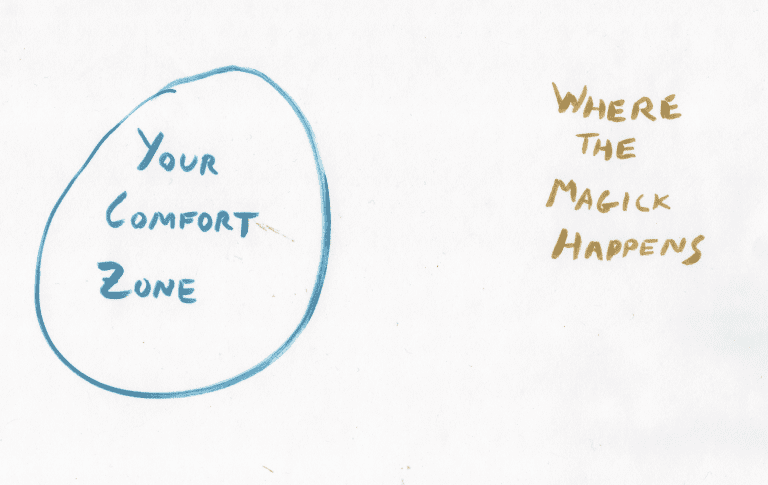 FIGURE 7
FIGURE 7
Where the Magick Happens
Anything that takes us out of ordinary consciousness, out of that comfort zone, that sets up some excitement or tension, can be used.
Part of the idea is, “If I can do this weird thing outside my comfort zone — if I can dance naked around this fire in the moonlight while my friends play drums — then I can do this other difficult thing to which I have set my intention.”
So an energy-raising practice has to stay weird. Otherwise it becomes a rote repetition with no ability to excite us. We’re always going to need rituals that are new to us — newly invented ones, ancient ones re-discovered, or ones brought to us from other cultures.
But whatever it is, you can’t do it half-assed. If you’re just going through the motions, there’s no energy.
Direction: Make the weird stuff connect in your mind with what you want
So here you are with this energy, this freedom from social convention. What will you do with it?
Lots of people will do weird stuff in their lives, just for the thrill, or out of a sense of rebellion, or whatever, but don’t do magick. Going back to that issue we had at the Fire Circle, and the people who were just there to party — lots of energy there, but no magick.
In fact I would say if there’s any danger in magick (besides the obvious of spraining your ankle while dancing in a ritual, or setting your house on fire with all those candles), it’s raising energy that you do not then properly direct. (Which can including grounding it out.) That’s what all those stories about magickians raising spirits (energy that can be personified) that then turn on them, is about.
To make the magick happen we need to direct that energy.
To do anything with electrical energy you have to build a circuit, a structure of wires and switches and transducers. To do anything with mechanical energy you have to build a machine, a structure of levers and pulleys and gears.
In the same way, to do anything with magical energy you need a structure. We call this a ritual or a spell or a working.
Generally a ritual is a more complicated thing that might involve several people over an extended time, while a spell is smaller and simpler and more verbal, but there’s not a hard line. We can argue over the labels, but what’s important is that there has to be a structure to direct the energy
And this structure we are creating is something in an artistic mode. Starhawk has said, “Ritual is partly a matter of performance, of theater”, and again I’ll quote Ross Nichols’s “Ritual is poetry in the realm of acts.”
What we’re doing is something of the same order as a poem or a play or a piece of music or a dance.
In fact all the different arts may be used as parts of rituals and spells, and all of the material arts may create ritual objects. In that respect, maybe we can say magick is a sort of meta-art!
In our little initiation ritual before, the structure was me convincing you that I have authority in that time and place — I’m playing a role, again a theatrical thing. And then me using that authority to tell you what you needed to hear. Pretty simple structure, but that’s the point, it can be just that simple.
The ritual or spell links our intention to the energy we have raised.
In an initiation ritual, we use the energy to alter our definition of ourselves. In a prosperity ritual, we use the energy to alter our relationship with money and wealth. In a healing ritual we mobilize physical, mental, spiritual, and social resources for healing.
The structure of a ritual can be elaborate or simple. So here’s where we get to that punk vs. prog distinction. It can be fixed by tradition or improvised on the spot. It may be a solo performances or created by groups; performed in front of hundreds of people or done alone; an original work or a “cover”.
On each of these choices, neither option is better than the other. We all have our own preferences on them.
But let me point out a few things to consider in designing a ritual or a spell.
Setting the stage
An effective ritual is marked as being outside of ordinary reality. Again, it’s similar to the way a play is separated from ordinary space and time: it takes place on a clearly demarcated stage, with rising and falling curtains and lighting to mark the start and the end.
Many rituals start by constructing a sort of “magic circle”. If you’re here for this workshop you probably have some idea what that is. Margot Adler gave a good explanation:
“The circle….is a place set apart, although its material location may be a living room or a backyard. But in the mind the circle, reinforced by the actions of casting it and purifying it, becomes sacred space, a place “between the worlds” where contact with archetypal reality, with the deep places of the mind – with “gods,” if you will – becomes possible. It is a place where time disappears, where history is obliterated. It is the contact point between two realities.”
So you want to have some way of marking your working, as being out of ordinary time and space.
In our little attunement earlier, I just flat out told you that “We are by definition not bound by the ordinary rules of time and space.” That’s kind of a primitive way to do it, by assertation, but in the context where we’re already in a festival (even on Zoom), we can get away with it.
Vestments
Just like the actors on a stage have their costumes that help them get into character, magicians have vestments.
Some prefer to don elaborate regalia to get into character for their rituals, while some use the most unusual outfit of all, the “birthday suit,” to break ordinary thinking. Certainly one can do a ritual in ordinary clothing; but dressing up (or undressing up) gives the thing a sense of occasion.
It’s why sports teams, armies, and doctors and nurses all have their uniforms. The Catholic priest has his stole, the Buddhist has their kesa. You put on your uniform and you take on a role.
Even just a piece of jewelry can help get you in the “this is special” headspace.
Implements
And just like actors have props, magicians have ritual implements.
Tools for manipulating the energy of ritual are found in every magical or religious tradition: the wand of ceremonial magicians, the holy water used by Catholic priests, the Wiccan athame [ah thm ay], the pipe of the Plains Indian tribes, the harae [ha rah ay] gushi whisk used in Shintō purification rites.
Some prefer ritual tools which are never used for mundane actions, in order to preserve a sense of occasion when the special tools come out. Like bringing out the good china for the holidays. Others, such as “kitchen witches,” prefer to use everyday objects and not build a division between the sacred and the mundane. My favorite Punk Magick tool is probably my multitool.
Rising and Falling Action
In most any play or story we have a narrative structure of rising action, climax, and resolution. If the story is long enough you have a few cycles of this rising and falling action.
Paralleling this, in a ritual we have the steps of raising power, directing that power, and resolving back to ordinary reality. And in a big working you might have a few cycles of this.
So these are just some things you can consider when thinking about how to direct the energy.
Now the next part is that “resolving back to ordinary reality” we just mentioned. Or the “cool down”.
Cool Down: Seal the deal
Anyone who’s made a New Year’s resolution knows, it’s one thing to make a change in your life; it’s another to make it stick. Our consciousness is thermoplastic: once it is “warmed up” by raising energy, it can be reshaped by the ritual. But then we have to return to the everyday world. (Sorry, but that’s how it is. You can’t stay on the mountaintop, the air is too thin and there’s no food.)
We have to let the mind cool in its new shape, let it firm up a bit, before being placed back into its regular use. Otherwise it will go back to it’s old shape as soon as it’s in its old environment.
So just like a novel, film, or play doesn’t cut off after the climactic moment — Luke blows up the Death Star and the film ends — an effective ritual must allow for a gentle resolution back to practical, “ordinary” consciousness. You need some cool down.
But since our goal is to emerge from the ritual changed, its a good idea for the resolution to guide us in a new direction, remind us of what has changed.
We often end group rituals by closing and dismantling the circle and saying “Merry meet, merry part, and merry meet again” – an excellent suggestion for an attitude to hold until next time.
In our little model ritual, I closed with a stock phrase “So mote it be”, then we had a little moment of silence to soak it in, and I took down the pentacle, then I cracked a small joke with the “I have spoken, do I need to browbeat anyone into accepting it” thing. All these things let you know “ok, we’ve taken your brain out of the furnace now, we’re letting it cool.”
Get off your ass!
Finally, the fifth step in this model is an oft-overlooked key to magick which was elucidated by our friend the Rev. Ivan Stang. I’m just going to give it to you in his own words from back in 1998, with an except from his “EARTH FIRST devival rant”. Just for fun let’s see if I can channel Stang a little bit here.
I wanna talk about MAY-JICKKKK and RELIGION and DUMB-FUCK SUPERSTITIONS.
I saw the $15,000 SCIENTOLOGY magazine.
“Somebody stole my bike, but I went and looked all over the neighborhood for it and I found it!”
That man learned KING “BOB” SOLOMON’S FIRST KEY to MAGICK:
GET OFF YOUR ASS.
If you want a girlfriend…. TALK TO A GIRL. If you want a new job — TALK TO OTHER COMPANIES. If you want to machine gun a stadium — GETTING OFF YOUR ASS. The first step.
Pretty important part of the process! And it’s worth going over the other keys he talks about. I think you could say these are more about how to work effectively in groups:
The SECOND KEY: BUST YOUR ASS.
Key 3: GET OTHERS TO BUST THEIR ASS FOR YOU. This we might call ASSHOLINESS.
The Fourth KEY: WATCH Your Ass.
If you do all these, you won’t have to worry about somebody trying to KICK YOUR ASS….
NEEDLESS TO SAY, all these rules SHOULD be PLAIN COMMON SENSE and GO WITHOUT SAYING. But some people are DENSE, and that’s what religions are for — reminders.
ALMOST FORGOT!! The most important rule of all, related to WATCH your ass:
WASH your ass. Yes, WASH your ass. Should be #1.
Magick opens the door, but you still have to step through it. There’s no substitute for putting in the work. (Wish there was!)
Now, in terms of our little model attunement, this part you have to do on your own. I can’t smell the flowers for you, I can’t be a magickian for you.
We Are All Magickians
Now maybe what we’ve been talking seems far away from our mundane experience. But magic is a part of our lives whether we make it deliberately or not.
Let’s look at familiar concrete example, and one appropriate to the upcoming Valentine’s weekend: a couple going out on a “date night.”
The date is by definition a special time, and they most likely go somewhere special, somewhere they do not ordinarily go. (At least, people did before covid.) They dress up for the night. Perhaps flowers are bought – an ancient magical tool dating back to Neanderthal times.
They share the intention to develop their romantic connection (at least, if the date is going to go well, they share that intention!), to make a deliberate change in their minds. They act in a non-ordinary manner, behaving in a more romantic fashion, however that may apply to their ideals.
With any luck, the date leads to an act of physical and emotional intimacy that draws them closer together. And the transition back to mundane life is gradual – if one partner immediately bolts out of bed and goes about their business, that’s not going to go too well.
And if it’s successful, it inspires them to do the work — get off their asses — that it takes to make a relationship succeed.
Magick is not something strange and foreign to our lives. Like I told you earlier, you are already all doing magick. So you might as well get good at it.
So: decide what you want. Do weird stuff. Make the weird stuff connect in your mind with what you want. Seal the deal. Get off your ass.
Now, go form a band.
Thanks for listening, and in conclusion I’d like to share some words, some great magickal advice, from Doktor Billy Bardo: “If magic is an art / Worked with will and from the heart / Listen to your inspiration and not to your fears.”
“If magic is an art / Worked with will and from the heart / Listen to your inspiration and not to your fears.”


